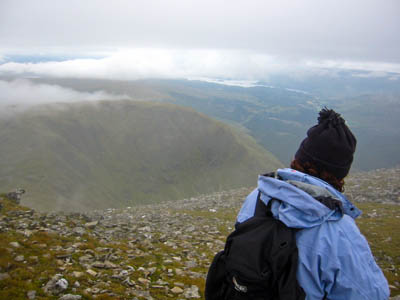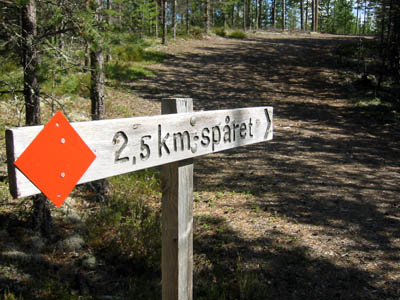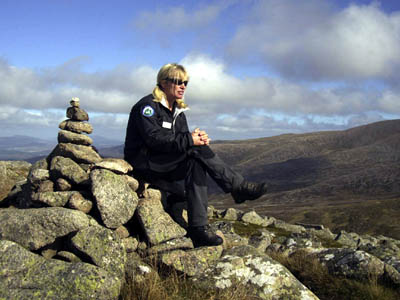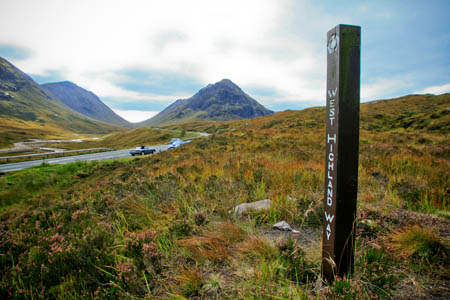
Cloud clears on the summit of Ben Lui: should routes up mountains such as this be waymarked?
Scotland stands accused of ‘mountain nihilism’ in its continuing opposition to adopting the practice of waymarking footpaths on its high ground.
Writing an opinion piece in the Herald newspaper, in which he admits he risks losing more friends than over any other subject, columnist Iain MacWhirter says it is almost impossible to find your way on the Highland’s mountains without a map, compass and local knowledge. It is, argues MacWhirter ‘time to end this silliness and start giving people the odd direction or two.”
The invective against the long-standing custom of leaving the nation’s mountains free from finger posts and yellow arrows brought a response from the chief officer of the Mountaineering Council of Scotland, who invited MacWhirter – clearly a lover of the hills – to spend a day on the mountains with the MCofS’s mountain safety adviser Heather Morning.
In an open letter to the newspaper, David Gibson says she would be able to explain to him why map and compass works, and why marking paths never will – at least not in Scotland.
In this week’s article the political commentator, who was earlier this year elected Rector of Edinburgh University, put the boot into Scotland’s hillwalking ‘elite’. Nowhere else in Europe, he argues, do visitors arrive and find an almost total lack of maintained paths and waymarks.
The Black Forest, he says, has 45,000km of waymarked hiking routes; Scotland 570km. In France, in the Haute Provence or Alps, there are 240,000km of routes maintained by 6,000 volunteers.
Visitors to Scotland arrive expecting to find waymarking and are shocked and bemused to find barely a cairn to guide them.

Waymarking on the Vasaloppsled route in Sweden
In Germany there are even rest shelters every few kilometres where fresh water can be found, a situation similar to that in Sweden where basic forest shelters can be used freely by walkers. Scotland does, of course, have a system of bothies, but these are not on the same scale.
There is a longstanding antithesis in Scotland to anything that is seen to despoil the wilderness. MacWhirter’s journalistic colleague Cameron McNeish has written against the construction even of simple cairns to guide the unwary walker when the Scotch mist is down. This attitude, says the Herald columnist, harks back to the historic background of the Highlands as a playground for the landed gentry, from which hoi polloi must be excluded.

Heather Morning: offer to guide Iain MacWhirter up Curved Ridge
He admits that, despite undertaking mountain leadership and Outward Bound courses, he still has difficulty finding the right buttress to start Buachaille Etive Mòr’s Curved Ridge. The MCofS’s Gibson says that MacWhirter needs the expertise of Heather Morning to show him how to navigate properly.
Far from increasing safety in the mountains, waymarking and maintaining footpaths might tempt the less able to take routes beyond their abilities, Gibson contends. He says in his response: “Encouraging ill equipped people – in terms of both equipment and basic skills – into the hills using marked routes, would be totally irresponsible.
“As evidence, I cite Ben Nevis. The tourist track up the Ben is well constructed, and marked on the summit plateau with cairns, yet there are incidents each year where walkers lose their way, sometimes with resultant injuries or fatal results in what can be at times an arctic climate.
“We would expect the logical outcome of marked paths to be more mountain rescue callouts. Presumably you would then be lobbying the Scottish Government for more financial support for mountain rescue to cope with the increase in incidents?”
And it simply doesn’t tally with experience that foreign tourists expect to see signs on the hills. The chief officer says: “A colleague of mine worked for four years for Cairngorm Ranger service. Her view is that this is not the opinion of the majority of visitors to the ranger base; many express the view that it is preferable to keep the mountains unmarked and untainted by human influences – factors which encourage self reliance and challenge.
“It is surely Scotland’s wild land which brings the visitors, not an expectation that marked paths will help them find their way!”
Scotland’s mountains demand respect, argues Gibson: “Knowing how to use a map and compass can save your life. Marked paths would not render their use redundant, but would simply encourage ill equipped walkers to venture into the hills expecting routes to be marked.
“What if they missed a marker? How regularly would you suggest marks be placed? Who would be responsible for deciding where to place them, or if one was accidentally missed, or if one was no longer visible? Who would be liable if there was an injury or fatality? And who would negotiate the marking of routes with land managers?
“The right to enjoy Scotland’s mountains is founded on traditional rights, now enshrined in the Land Reform (Scotland) Act 2003.
“MCofS fought hard to gain these legal rights and we continue to act on a large number of access issues despite the legislation. We also recognise that mountaineers have a duty to respect the landscape, both in terms of our impact, and the risks involved, and we provide a range of educational and information resources on our website to help hill-goers understand the issues and how to deal with them.

The West Highland Way is one of few waymarked routes in Scotland
“Mountaineering in Scotland is important to the health of many, and to a rural economy where visitors from home and abroad come to enjoy what is left of our wild land. Regarding visitors to Scotland, we would like to see your evidence for the assertion that visitors from overseas expect to see marked routes.”
The debate over safety and signs on routes has rumbled for years and resurfaces whenever there are fatalities. Two recent deaths on the Clachaig Gully route off Aonach Eagach have sparked heated exchanges over the desirability of warnings either on the route or on nearby car parks.
Ben Nevis, the most enticing honeypot of Scottish mountaineering for inexperienced walkers, has signs explaining the dangers of the route. Last winter, mountain rescue teams in the English Lake District put up signs urging walkers to go equipped with ice-axe, crampons and the knowledge of how to use them after a spate of accidents on snow and ice, and North Wales Police appealed for Snowdon to be left to experienced winter mountaineers after three deaths in close succession.
Both the MCofS and the British Mountaineering Council stress the risks involved when walkers take to the hills. The Scottish council’s participation statement says: “The MCofS recognises that climbing and mountaineering are activities with a danger of personal injury or death. Participants in these activities should be aware of and accept these risks and be responsible for their own actions and involvement.”
MacWhirter says: “Hillwalking is a mass participation sport and people come here from all over the world.
“You can’t just tell them not to come unless they’ve spent 20 years learning all the routes. Anyway, it is a kind of conceit, a form of vanity, that only people who are experts in hillcraft should be allowed to go on the hills. It is mountain apartheid. The paradox of wild land is that it has to be managed to keep it that way. It’s time to start telling hillwalkers where to go.”
Heather Morning told grough she will visit the Clachaig Gully within the next few days to see just what the problems are at the site, which is not recommended as an escape route from the aonach. She is also interested in cataloguing Scottish mountain blackspots, to make walkers and mountaineers aware of the potential hazards at the usual accident sites.
For all the arguments, it is clear that hillwalking is still relatively safe. Both MacWhirter and Gibson agree on that.
“The number of mountaineering incidents has varied little since 1980 despite many more venturing to the hills,” the MCofS chief says. “The fact that there are so few mountaineering accidents isn’t due to one factor; it’s due to a wide range, including improved clothing and footwear; availability of navigation courses, better guidebooks and maps; improved information on mountain safety, avalanche conditions and mountain weather; better training of mountain leaders; and better educated and informed hill-goers.”
Nihilism or not, the debate over Scotland’s wildernesses will continue. And people will continue to climb its mountains, with or without waymarks.
Tinto63
28 July 2009If Iain MacWhirter wishes to walk a Scottish hill that is waymarked he should try Queensberry, east of Thornhill. He may have difficulty, however, negotiating the unsigned single track roads that lead to the usual parking place!
Although I don't object to the waymarkings in this case, I am very grateful that the vast majority of hills are free of any signposts or directions. Like most hillwalkers I have gone up the wrong ridge on one or two occasions, but this is the way you learn about the hills and keep alert on your map and compass skills.
Part of the great satisfaction of hillwalking is finding your way to an unpathed summit, usually a little visited Corbett or Graham in thick weather and knowing that you can find your way down safely.
Jon
29 July 2009"if you go to the French Alps or the German Black Forest, you can hardly move for signs telling you where you are, where you are going and how long it is going to take to get there" - sounds great doesn't it, I'd love to go there and bump into signposts all the time.
This MacWhirter guy really doesn't have a clue does he - here are another couple of quotes:
"the principle cause of erosion is the impact of the aimless feet of thousands of hill walkers losing their way"
" it is almost impossible to find your way around without a map and compass and a good deal of local knowledge".
Total nonsense - walkers losing their way is not even a significant cause of erosion, and a map and compass (and a little common sense) are perfectly adequate without any local knowledge.
I'd like to point out to Mr MacWhirter that I am one of the "hoi polloi" and certainly not landed gentry!
andyr
29 July 2009NO, no, no to waymarking on the ground, if you want waymarks, you can download them and follow the gps to the top.
I quite like the idea of route start markers on the verge of the public highway, it could even have an OS grid reference to be obscure enough, not essential though.
A map and compass and the knowledge to use them totally enhances the experience of the wild, you can identify landmarks as well as work your way off or onto the hill.
No local knowledge is required providing common sense is adopted, you know where you are, what direction you are pointing and which natural hazards are imminent or likely. All of which you get from a map and compass, few or none of which you get from a signpost.
andyr
Jhimmy
29 July 2009Yep, the silly people are coming out for their summer holidays again. Why is it that we "need" to be told where to walk?
I love the ability to look at a mountain or hill and decide I like that line of ascent. I often wonder if I'm the only person to have climbed that small gully, ridge, stood at that view point, etc.
We are now a society being told increasingly what to do... put that wheely bin out on a Friday! You can't park your car there! You're not allowed to view that on the internet! Don't walk that ridge because it doesn't havea path on it!
I pity the future generations not being able to think for themselves.
Slyspeed
31 July 2009If Mr MacWhirter knew how to read a map and use a compass he would realise that all hill routes are marked on the OS maps. You just have to plan them yourself. As for the idea of waymarked paths, there are only manmade paths on a few hills in scotland, usually to control erosion on popular routes. These, and the stalkers paths, are usually marked on the map. the lack of other waymarkers expresses the Scottish freedom to roam.
If Mr MacWhirter would still like all these waymarkers, would he care to tell us who would pay for them all?
T Schenk
16 August 2009I am dismayed by some of the remarks in the story and in the subsequent comments.
I recently enjoyed a holiday in the Scottish Highlands (including a walk up Ben Nevis) but I was bemused by the lack of signs or pointers on the hills. In the Alps, it's not uncommon to see signs indicating the estimated time to the next waypoint, and many routes are signposted by helpful (and unobtrusive) paint marks on the rocks. Why don't these exist in Scotland?
It seems there is a lot of snobbery when it comes to the Scottish hills. The outdoors are to be enjoyed by everyone.
BruceW
01 September 2009To T Schenk and the likes.
You are missing the point and I'm afraid you will never understand why true hill walkers are against signs. Until you have felt the satisfaction of navigating your way up, down or through the Scottish hills successfully then any argument will be lost on you. (which is very sad indeed!)
Carolo
31 January 2010T Schenk is right in my book - the reply to him illustrates perfectly the snobbery involved where it quotes 'true hillwalkers'! It's not as if being a 'true hillwalker' only depends on your standard of GPS use (another cheat) anyway - there are many more factors.
In any case, it is totally impossible to find exactly the correct buttress to start a scramble or climb on complicated ground, for instance at the base of Buachaille Etive Mor, on a 1:25000 map, which is the most detailed we have at present. You would need around a 1:1000 or suchlike and then it would be very cluttered and complicated and difficult to read - you would also need to carry a great many of them out on the hill with you for a walk!
A lot does depend on local knowledge - I'm extremely familiar with the Lakes fells so don't usually refer to a map at all in bad visibility as I know where I am - I can't say the same about Scotland as I mainly make few visits to each particular area, it being a much larger mountain area.
I think it's time all the elitism stopped and average navigators were welcomed to the Scottish mountains. Why should you have to be absolutely expert to be allowed near a Scottish mountain?
In any case, there is no true wilderness in Britain as these islands are too populated for that so it's no good giving that excuse for not having any signs at all!
I won't be back on this particular forum so don't bother to sling loads of elitist abuse at me thanks....
Derek
09 December 2010This snobbery argument is absurd. All that is being said is that you need to learn what to do before you venture into the Scottish Highlands. It doesn't take long... It doesn't even cost very much.
And if you think hillwalking is the preserve of the well-to-do, just check out the number plates on the cars in the baggers' lay-by's all over the Highlands. You'll be surprised how old are many of the cars.
Otherwise, the logical conclusion is that it's snobbery to learn about anything.
Nike Air Max 87 Grå Blå Grön För Haven
22 May 2015Jag antar att jag kunde ställa frågor om din artikel, men eftersom det är så klart jag antar att jag ska bara göra en kommentar. Jag tror att den här informationen är välskriven, nyttig och intressant.